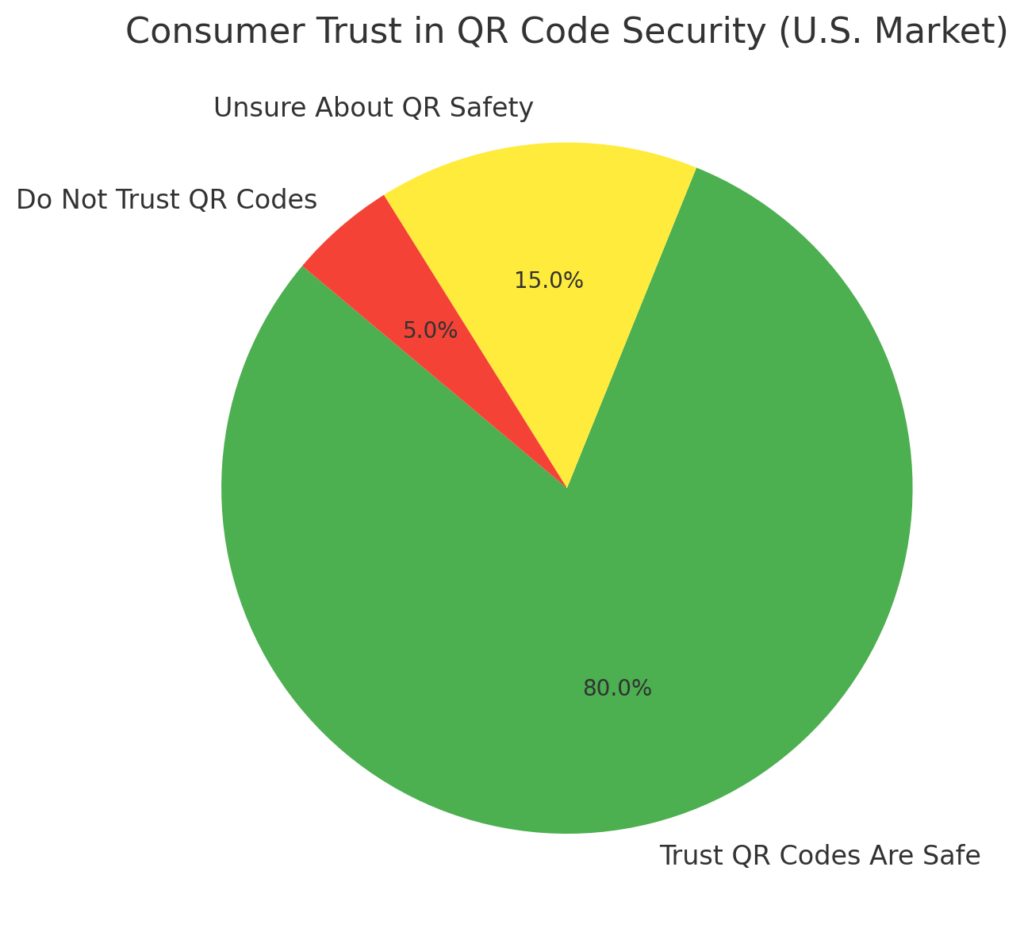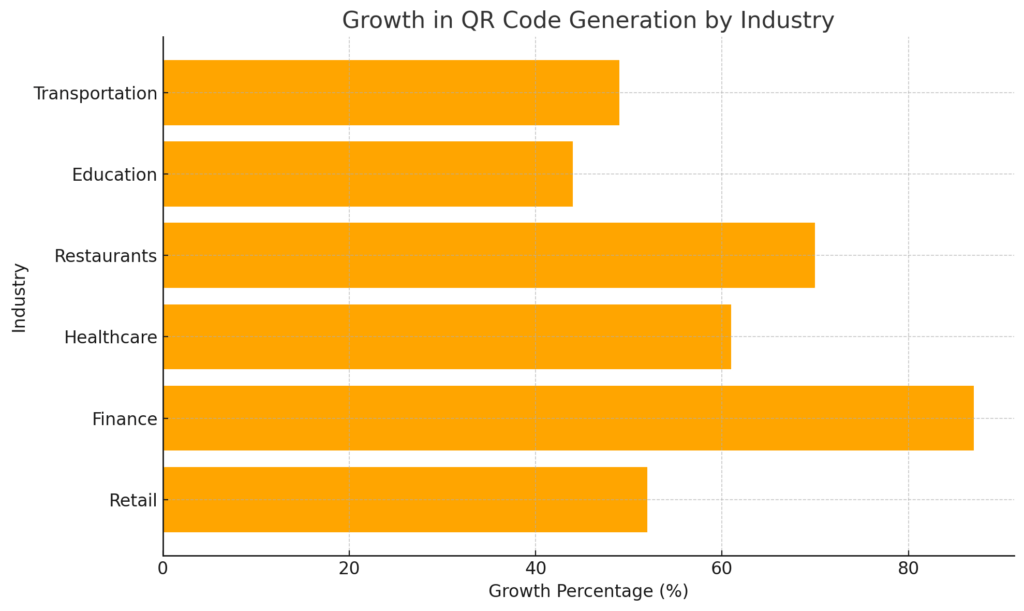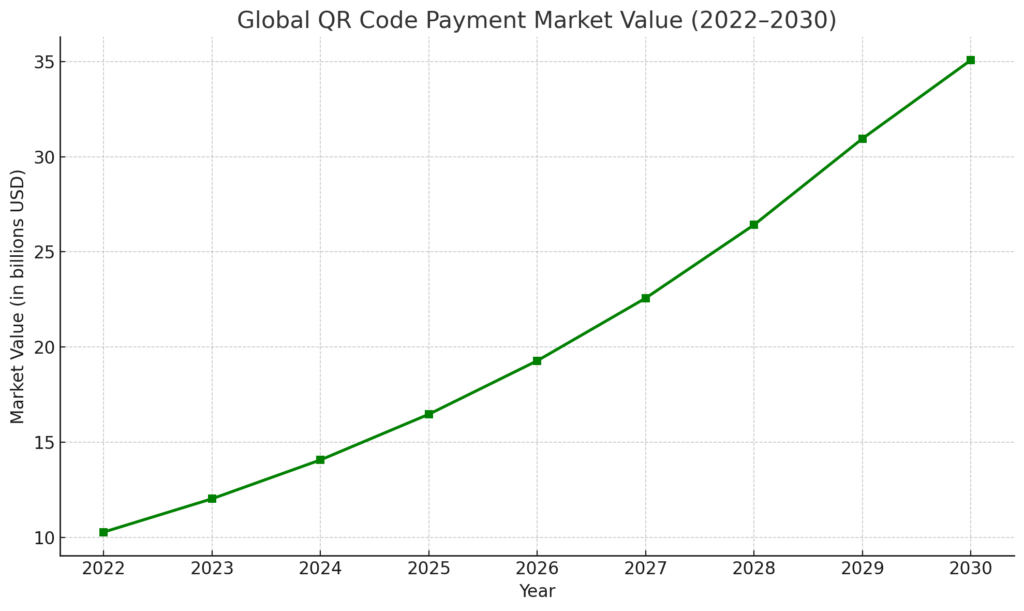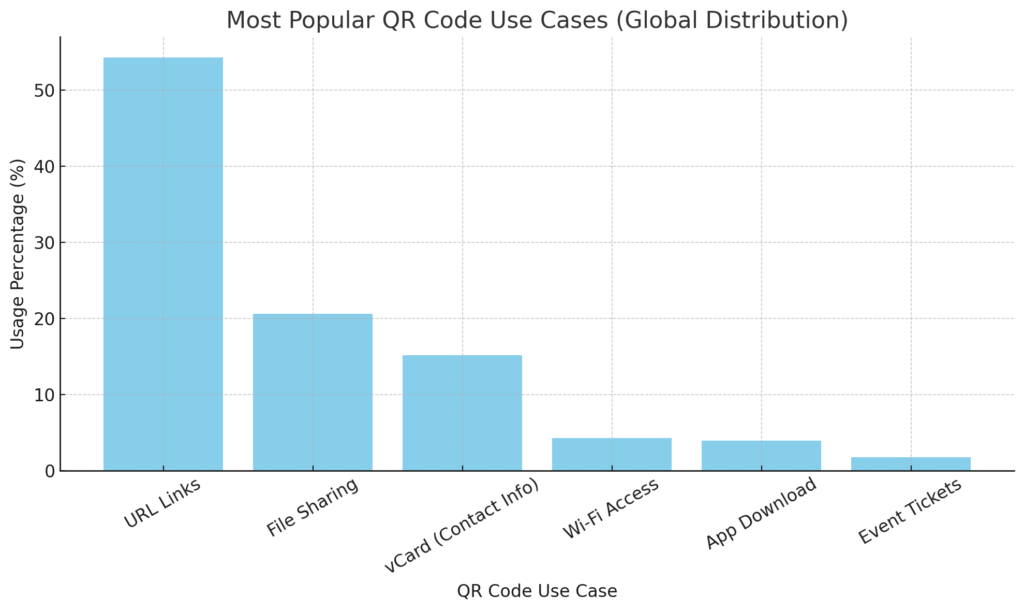
23 Mar QR CODE STATISTICS 2025
Over the past five years, QR codes have evolved from a niche tech feature to a global necessity—shaping how we shop, dine, travel, pay, and interact with brands. Originally created in the 1990s for tracking automotive parts, QR codes have surged in popularity thanks to the widespread use of smartphones and the growing demand for contactless experiences. From restaurant menus and product packaging to payment gateways and marketing campaigns, QR codes are now a staple in both digital and physical consumer journeys. At Amra and Elma, as we move further into a tech-integrated future, the adoption of QR codes is showing no signs of slowing down. In this article, we explore the top 15 QR code statistics from the last five years and projections for what lies ahead—each paired with insights into what these trends mean for businesses, marketers, and consumers around the world.
QR CODE STATISTICS 2025 (Editor’s Choice)
Over the past five years, QR codes have experienced significant growth across various industries, and projections indicate this trend will continue. Here are the top 15 QR code statistics from recent years and forecasts for the future:
Global Market Growth: The global QR code market was valued at $1.5 billion in 2023 and is projected to reach $3.5 billion by 2033, registering a compound annual growth rate (CAGR) of 8.7%.
U.S. Market Expansion: In the United States, the QR code market was valued at $233 million in 2023 and is expected to reach $568.8 million by 2033, with a CAGR of 5.4%.
User Adoption in the U.S.: Approximately 83.4 million adult smartphone users in the U.S. (37.5%) scanned QR codes in 2022, a figure projected to rise to 42.6% by 2025.
Global QR Code Scans: QR code scans reached 41.77 million globally in 2025, marking a 433% increase over the past four years.
Year-on-Year Generation Growth: There has been a 47% year-on-year growth in QR code generator across all countries.
Popular QR Code Solutions: The most widely used QR code solutions are URL (54.33%), File (20.61%), and vCard (15.13%).
China’s Adoption: Over 90% of mobile payments in China rely on QR codes, with users interacting with them 10-15 times daily.
Japan’s Payment Methods: QR code payments have become the second most popular cashless payment method in Japan, surpassing electronic money.
European Market: In Europe, QR code payments were valued at $1.6 billion in 2021 and are projected to reach $2.3 billion by 2025.
Mobile Payment Growth: The global QR code payment market was valued at $10.28 billion in 2022 and is expected to grow at an annual rate of 17.03% until 2028, reaching $35.07 billion by 2030.
Consumer Trust in the U.S.: Approximately 80% of U.S. consumers who use QR codes believe they are safe.
Usage in Marketing: Over half of U.S. businesses utilize QR codes for marketing purposes, enhancing customer engagement.
Restaurant Industry Adoption: Approximately 70% of U.S. restaurants have implemented QR codes for menus and payments, with 58% of customers preferring digital menus accessed via QR codes.
Financial Sector Growth: The finance industry saw an 87% growth in QR code creation, indicating a shift towards QR-based transactions.
Projected U.S. User Growth: The number of U.S. smartphone users scanning QR codes is expected to increase by 16 million from 2022 to 2025, reaching 99.5 million users.
These statistics underscore the rapid adoption and integration of QR codes globally, driven by their versatility and the increasing demand for contactless solutions.
QR CODE STATISTICS 2025
QR CODE STATISTICS 2025 #1. Global Market Growth
The global QR code market was valued at $1.5 billion in 2023 and is projected to reach $3.5 billion by 2033, with a CAGR of 8.7%. This rapid growth highlights the increasing demand for contactless, digital-first solutions across industries. As brands continue to prioritize seamless customer experiences, QR codes will likely become a standard feature in product packaging, events, and marketing campaigns. The expansion of the global market also signals increased investment in QR technology and smarter QR platforms with analytics and integration capabilities. For businesses, this means that early adoption and innovation in QR code usage could provide a significant competitive edge.
QR CODE STATISTICS 2025 #2. U.S. Market Expansion
In the U.S., the QR code market was valued at $233 million in 2023 and is expected to hit $568.8 million by 2033. Despite being a relatively mature market, the U.S. is still seeing consistent growth in QR code adoption, particularly in retail, hospitality, and healthcare. The growth suggests that American consumers are growing more comfortable with QR code usage and expect it in everyday interactions. Businesses that fail to offer QR-based options may be perceived as outdated or inconvenient. Going forward, brands should consider integrating QR codes not only for payments but also for loyalty programs, product information, and exclusive content.
QR CODE STATISTICS 2025 #3. U.S. User Adoption
Approximately 83.4 million adult smartphone users in the U.S. scanned QR codes in 2022, and this figure is projected to rise to 42.6% of smartphone users by 2025. This widespread adoption signals a cultural shift toward more self-guided, tech-driven experiences. Consumers now expect the ability to engage with products and services through their smartphones, whether it’s to view a restaurant menu, claim a discount, or verify product authenticity. For marketers, this growth represents an opportunity to use QR codes as gateways to branded digital experiences. The trend also indicates that consumer education around QR codes has improved significantly, reducing friction in adoption.
QR CODE STATISTICS 2025 #4. Global QR Code Scans
By 2025, global QR code scans are expected to reach 41.77 million, marking a 433% increase in just four years. This explosive growth is a testament to how embedded QR codes have become in global consumer behavior. Much of this can be attributed to the pandemic-driven push for touchless solutions, but the sustained increase shows that QR codes are here to stay. As scanning becomes second nature, QR codes will likely become even more central to loyalty programs, app downloads, and real-time engagement. Companies that incorporate QR codes into their long-term digital strategies will be better positioned to meet customer expectations.
QR CODE STATISTICS 2025 #5. Year-on-Year Generation Growth
There has been a 47% year-on-year growth in QR code generation worldwide. This surge demonstrates that businesses across industries are increasingly experimenting with QR technology to enhance customer experience. With more companies generating QR codes, competition for attention will rise, pushing brands to create more visually engaging and functional codes. In the future, we can expect QR codes to evolve in design, with more emphasis on dynamic content and customization. Marketers should stay ahead by incorporating branding into their QR designs and tracking user behavior through dynamic QR code analytics.

QR CODE STATISTICS 2025 #6. Popular QR Code Solutions
The most used QR code solutions are URL (54.33%), file sharing (20.61%), and vCard (15.13%). These preferences reveal that consumers primarily use QR codes to access information quickly and conveniently, especially for browsing websites, downloading documents, and saving contacts. The dominance of URL-based QR codes suggests they will remain an essential tool for driving web traffic from offline media. Meanwhile, the rise in vCard usage presents new opportunities for professionals to network more efficiently at events or conferences. As users grow more comfortable with QR code features, the demand for advanced functionalities like payments, app downloads, and social media integrations will grow.
QR CODE STATISTICS 2025 #7. China’s Adoption
Over 90% of mobile payments in China rely on QR codes, with many users scanning QR codes 10 to 15 times daily. China has set a global precedent in QR code adoption, largely driven by platforms like WeChat and Alipay. This high-frequency usage shows how QR codes can become a dominant form of interaction when seamlessly integrated into daily life. Western markets may follow this model, particularly as digital wallets become more commonplace. Global brands should study the Chinese market to learn how QR codes can be used not only for payments but also for customer engagement, social interaction, and digital ID verification.
QR CODE STATISTICS 2025 #8. Japan’s Payment Shift
In Japan, QR code payments have become the second most popular cashless payment method, surpassing electronic money. This trend underscores the versatility and accessibility of QR code technology, especially in a country known for its traditional cash-based society. The rise of QR codes in Japan also highlights how a blend of government initiatives and retailer incentives can accelerate adoption. For other countries, Japan’s transformation offers a case study in how to promote secure, widespread mobile payment options. In the coming years, QR code payments could overtake credit cards in some regions as consumers seek faster, more intuitive solutions.
QR CODE STATISTICS 2025 #9. European Market
Europe’s QR code payment market was valued at $1.6 billion in 2021 and is expected to grow to $2.3 billion by 2025. While Europe has traditionally been slower to adopt mobile payments, QR codes are gaining traction in sectors like hospitality, public transport, and ticketing. This growing market opens the door for innovation in QR-based loyalty programs and cross-border payment solutions. Additionally, European privacy regulations may push the development of more secure QR code technologies. Brands in the region should invest in QR code campaigns that emphasize convenience, security, and compliance with data protection laws.
QR CODE STATISTICS 2025 #10. Mobile Payment Growth
The global QR code payment market was worth $10.28 billion in 2022 and is projected to grow at 17.03% annually through 2028, reaching $35.07 billion by 2030. This remarkable growth shows that QR payments are not a trend—they are the future. As mobile payment systems expand, QR codes will be the connective tissue between physical products and digital payments. Businesses that adopt QR-based checkout systems will benefit from reduced hardware costs and increased transaction speed. This shift may also democratize payment technology, allowing even small businesses in developing regions to accept digital payments.
QR CODE STATISTICS 2025 #11. Consumer Trust in the U.S.
About 80% of U.S. consumers who use QR codes believe they are safe, showing strong trust in this technology. This trust is essential for continued adoption and opens the door for more sensitive transactions, such as banking, health records, and ticketing. Businesses must maintain this trust by avoiding broken links or malicious redirects and ensuring that QR codes lead to secure, legitimate destinations. Moving forward, QR code platforms with encryption, tracking, and real-time validation features will be crucial. As trust grows, consumers will be more willing to scan codes in a broader range of settings.
QR CODE STATISTICS 2025 #12. QR Codes in Marketing
More than half of U.S. businesses are now using QR codes in their marketing strategies. This wide adoption demonstrates that QR codes are seen as essential tools for bridging offline and online engagement. Whether on billboards, packaging, or receipts, QR codes offer real-time access to discounts, reviews, or branded content. Their flexibility means they can be integrated into both short-term promotions and long-term loyalty programs. Future marketing will likely rely even more on QR codes for personalized experiences, real-time feedback, and tracking offline ROI.

QR CODE STATISTICS 2025 #13. Restaurant Industry Adoption
Around 70% of U.S. restaurants have adopted QR codes for menus and payments, and 58% of customers prefer digital menus. This shift reflects a broader digital transformation in the hospitality sector, accelerated by the pandemic. Customers enjoy the convenience of instant menu access and contactless ordering, while restaurants benefit from reduced printing costs and easier updates. Going forward, restaurants may use QR codes to deliver dynamic menus, collect feedback, and personalize dining experiences. Those who resist this change risk being seen as behind the curve in customer service innovation.
QR CODE STATISTICS 2025 #14. Financial Sector Growth
The finance industry has seen an 87% increase in QR code creation, signaling a growing reliance on QR codes for secure and efficient transactions. Financial institutions are embracing QR codes for banking apps, virtual business cards, and even investment product information. This growth reflects consumer demand for quick, paperless interactions in an industry known for its documentation. As the industry digitizes further, QR codes could serve as secure gateways for biometric authentication, real-time investment updates, and personalized financial advice. The future of finance is likely to be both mobile-first and QR-driven.
QR CODE STATISTICS 2025 #15. U.S. User Growth Forecast
The number of U.S. smartphone users scanning QR codes is expected to increase by 16 million from 2022 to 2025, reaching 99.5 million users. This trajectory suggests that QR codes will soon become a daily habit for nearly half of the U.S. adult population. The rising adoption rates open opportunities for enhanced mobile commerce, real-time surveys, and geolocation-based promotions. Brands should be proactive in integrating QR codes into product packaging, storefronts, and advertisements to capitalize on this growing familiarity. As QR scanning becomes routine, businesses that offer useful, value-driven experiences through QR codes will thrive.

Conclusion
The data is clear—QR codes are no longer just a temporary solution or a pandemic-era workaround; they are a powerful tool shaping the future of consumer engagement, mobile payments, and marketing. With billions of scans annually, soaring global adoption rates, and expanding applications across industries, QR codes are proving to be an essential bridge between the physical and digital worlds. As consumer trust and familiarity with QR codes continue to grow, businesses that invest in creative, secure, and value-driven QR code experiences will be best positioned to stand out. Whether it’s simplifying checkout processes, delivering personalized content, or enhancing offline marketing efforts, QR codes offer endless opportunities for innovation. The future belongs to brands that not only embrace QR technology but also use it strategically to build stronger, smarter connections with their audience.
Sources:


